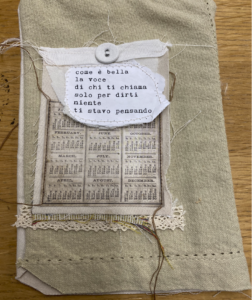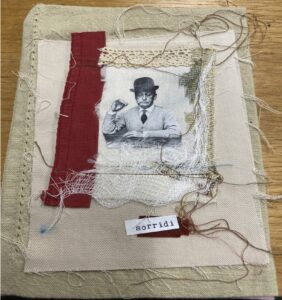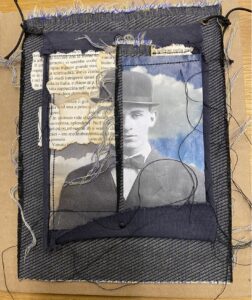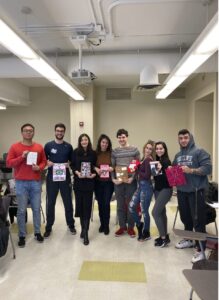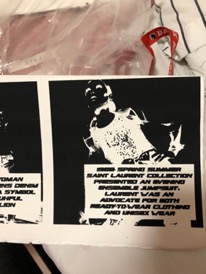Poesia scritta da Iroda nella classe Italian 204
Cucite per recuperare,
Cucite per dimenticare le vostre ferite,
Cucite per ricordare la vostra provenienza
Dall’altrove
E per creare un percorso Nuovo,
Una nuova fiaba che si trasforma
Nella nuova realtà
In cui non c’è più la crudeltà.
Cucite per creare lenzuola ampie
Come l’orizzonte.
Esprimete la vostra caparbietà
Attraverso il filo che
Accomuna tessuti come umanità
La caparbità è un aggettivo perfetto per descrivere Maria Lai. Il percorso dell’artista era incredibile per le donne del suo tempo. L’artista e la scultrice l’ha sposata con il suo telaio, I suoi fili e I suoi aghi. Le trame intessute, le tele cucite e le lenzuola ampie sono I suoi figli. Apparentemente, l’idea di usare l’arte come il suo dispositivo per insegnare alle persone che dobbiamo essere accomunati attraverso l trame intessute e attraverso l’arte pubblica, è diventata la sua devozione.
Iroda/Pagina Cucita – Descrivere il Vostro progetto
Per il mio progetto artistico ho usato felro e cotone con elementi Ikat. Ho usato feltro Azzurro e beige perchè per me il colore Azzurro rappresenta il cielo, la libertà e, in certa misura, la purezza e la calamità e il beige mi ricorda della terra. I fili rossi simboleggiano il sangue e la vita, Azzurro enfatizza la libertà. Per me la libertà di scelta è una delle cose più important della vita. Il materiale Ikat ha diversi colori: rosa, giallo, bianco e grigio. Per me anche I colori della sciarpa hanno un significato. Il rosa è la felicità, il grigio è tristezza, il giallo è il sole e il banco è calamità e chiarezza mentale.
Ho tagliato una mia sciarpa per questo progetto. Gli ornamenti Ikat sono utilizzati nel mio paese di origine e soddisfano il requisite di utilzzare qualcosa di personale. Mi ricorda casa. È anche fatto a mano. Dunque a Maria Lai piaceva creare materiali e fare libri fatti a mano, quindi la sciarpa fatta a mano era un buon modo per renderle omaggio. Maria Lai mi ispira perchè era una donna che ha seguito I suoi sogni e non ha lasciato che gli stereotipi di genere si fcessero strada. Alla fine ho usato immagini di film e musica italiani. Il legame tra Ikat e la cultura italiana rappresentano la diversità
Eduardo Marino, Le pagine della vita
Le esperienze sono come fili che si uniscono per formare la persona che siamo,
Sono come il sottotitolo di un libro che definisce le nostre caratteristiche,
Il modo in cui vediamo le cose,
Il modo in cui ci vestiamo,
Il modo in cui parliamo,
Però soprattutto le cose cucite su ogni pagina che segnano la nostra storia per sempre
E indicano la nostra identità
E indicano chi diventiamo
Eduardo Marino / Pagina cucita
In questo progetto, ho fatto una pagina
Utilizzando una maglietta Bianca del Queens College Athletics, cucita su un materiale più solido, anche bianco.
Ho scelto il tema del Brasile perchè sono brasiliano e volevo rappresentare il mio paese insieme alla mia partecipazione alla squadra di tennis negli Stati Uniti.
Inoltre ho selezionato un filo giallo e anche il colore verde perchè sono I colori del Brasile.
Dopo, ho scritto una parte di una canzone brasiliana molto famosa e anche la sua traduzione in italiano. Per finire, ho scelto due immagini che mostrano località turistiche molto conosciute in Brasile, una di Cristo Redentore, a Rio de Janeiro, e un’altra del Ponte Estaiada, a San Paolo. Maria Lai mi ha ispirato a fare questo progetto perchè ho usato materiali diversi per rappresentare parte della mia identità su una pagina cucita, come faceva con le sue opera.
Sun Youtian/ his fabric book
Il mio lavoro è un fumetto. Per prima cosa ho cucito un libro con stoffa e ricami. Quindi ho usato un computer per disegnare e ho creato una serie di fumetti. Quando ho realizzato questo fumetto, sono stato influenzato da Maria Lai, che ha usato il Ricamo per scrivere parole illegibili sul tessuto. Il mio lavoro è differente. Non ho creato un testo illegibile, perchè sono appassionato per l’apprendimento delle lingue straniere. Ho usato una parola diversa per ogni lingua, “Rien” (niente) in francese, “mano” in italiano, il terzo in Tedesco “Mehr” (di più) il quarto in giapponese … (occhi); e la quinta è cinese che significa “complete/tutto”. Dunque dal nulla abbiamo completato il progetto.
Poesia di Maria Costa- Il mare e I venti.
Mare, infinito mare,
Impossibile non cantare
I tuoi mutamenti
Ieri feroce come una fiera ferita
Forti venti agitavano le onde
Oggi calmo e tranquillo
Una brezza fresca accarezza la mia faccia
E tutto il mio corpo soavemente abbraccia
Sempre cambiando, mai lo stesso
Schiavo dei venti e delle maree
Nessuno saprà come sarà domani
Inaspettate sorprese ogni giorno crea.
Sea, endless sea,
Impossible not to sing
Your changes
Yesterday wild as a wounded beast
Strong winds agitated the waves
Today calm and serene,
A fresh breeze caresses my face
And gently embraces my whole body
Always changing, never the same,
Slave of winds and tides
No one will ever know how you will be tomorrow
Creating unexpected surprises every day
Sun Youtian – Poesia
La vita è un filo dell’ago che si insieme si intrecciano.
Il tempo passa, è come un flusso d’acqua.
Tesserò il tuo future con un ago,
Sei lontano, ma mi sembra vicino.
Sono seduto da solo in una stanza vuota,
La tessitura appartiene al nostro futuro.
Quando torni.
Sarò già pieno di capelli bianchi.
Tessere ancora la tua storia tra le mani.
John Sullivan, “Ruminations in Isolation”
Like huddled stars
In dusky sky,
Which seem intimate
To the eye,
Are really very far apart,
So act our friends
Who hide away
Their truest selves
From light of day,
In the darkest skies of their own hearts.
Georgine Ingner
Mother Earth
How much she is sacred
Mother Earth
How she protects us
Nurtures us
Gives to us
It is a pity that humanity
Thinks little of her
We are dirty
We waste
While we watch her die.
John Sullivan, Elucubrazioni sull’isolamento
Come le stelle
Raggruppate nel cielo,
Che sembrano vicine
L’una all’altra,
Ma veramente sono lontane,
Cosí I nostril amici
Che nascondono le loro verità
Non mostrano se stessi,
Nella luce del giorno
Nella profondità dei loro infiniti cieli notturni.
Gerorgine Ingber, La Madre Terra
Quanto è sacra
La Madre Terra
Come ci protegge
Ci nutre
Ci dà
È un peccato che l’umanità
Pensi poco a lei
La sporchiamo
Sprechiamo
Mentre la guardiamo morire
The midterm exam was a project to be done in steps and involved working with different media.
1. read the brochure on Maria Lai’s exhibition at the MAXXI in Rome.
2. do research on the artist. Prepare a power-point with the most important aspects oh her life and work.
3 .select one of her works and comment on it, say why it was important etc.
4. select material for their own textile work that together we decided to call “Pagina cucita” (sewn page)
We brought to class different fabrics and we discussed the possibilities.
We discussed how to compose the page, how to use threads or other kinds of material, a photo, a poem, etc.
One of the students attending the class, Georgine Ingber (Director of Creative Services, Communication and Marketing at Queens College) who is also an artist brought to class her first experiment (see picture in following slide) and we examined it together. Her work and interpretation of the themes we discussed was an inspiration.
Each student completed their page and as a further step they had to describe their project and explain their choices.
We practiced writing this text, the vocabulary, grammar etc.
The Final Exam
The Final Exam contained a reflection on the Lai project that intersected with art, material culture, fashion, poetry and the history of women.
As one of the questions, I included a paragraph with the following quotation: “Il rapporto con l’infinito è essenziale per essere umani… La bellezza e l’arte, apparentemente cosí inutile, ci salvano la vita. L’arte come la fragile barca di carta che deve affrontare l’infinito.” dice Maria Lai. Ritroviamo cosí quell’idea di infinito che insieme all’idea di legame e di relazione, è al centro del lavoro di Maria Lai.[…] Il suo filo è idealmente senza fine perchè allude al filo dell’arte che non si esaurisce mai. Oltrepassa dunque I confini del telaio, del lenzuolo, del libro, della pagina e ci conduce tenendo per mano l’ombra e tenendo per mano il sole verso altri orizzonti, altri spazi, altri mondi (Elena Pontiggia).
Translation of the previous paragraph.
The relationship with infinity is essential in order to be human…Beauty and art, apparently useless, save our life. Art as a fragile paper boat that must face infinity… (says Maria Lai). Her thread (FILO) ideally has no limits because it alludes to the thread of art that is never exhausted. It goes beyond the borders of the loom, of the book, of the bed sheets, of the page and leads us towards other horizons, other worlds, other spaces while we hold the hand of the shadow and of the sun. (Elena Pontiggia)
A selection of sentences written by the students
Veramente non possiamo vivere senza l’arte, ma questa vita sarà più triste e grigia. Persino le persone primitive usavano dipinti rupestri. […] L’arte può ispirarci, eccitarci, provocarci, ma alla fine è come dicono I russi, è un balsamo per la propria anima. Trova sempre un modo per connetterci. […]
Anche se trovo che tutte le opere di Maria Lai siano interessanti e insolite, uno dei suoi progetti che mi ha parlato di più è quello di “Legarsi alla montagna” un progetto di arte pubblica relazionale. Sono rimasta sorpresa dal suo scopo. Nastri blu come tante strisce di lenzuola che coprivano le stradine e le montagne del suo paese, Ulassai. Questi nastri, da un lato hanno collegato la comunità rendendola più forte e dall’altra per il contrasto di colori e l’ampiezza geografica, sembrava infinito e liberatorio. per i bambini e le persone del paese. Il progetto stesso crea “l’ansia di infinito” come infiniti sono gli orizzonti e la conoscenza che possiamo ottenere durante la nostra vita. (Iroda)
